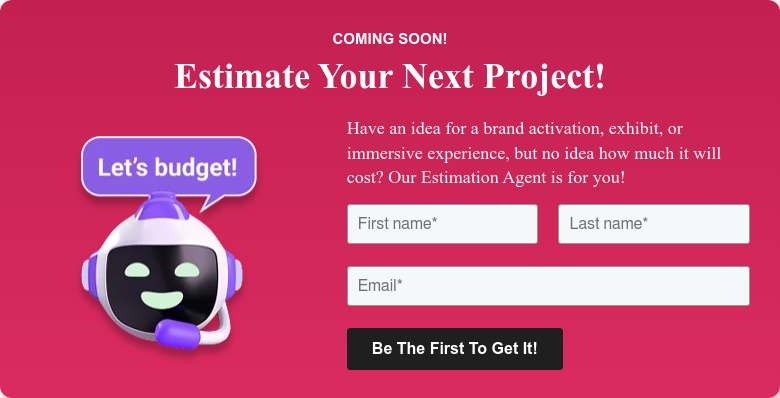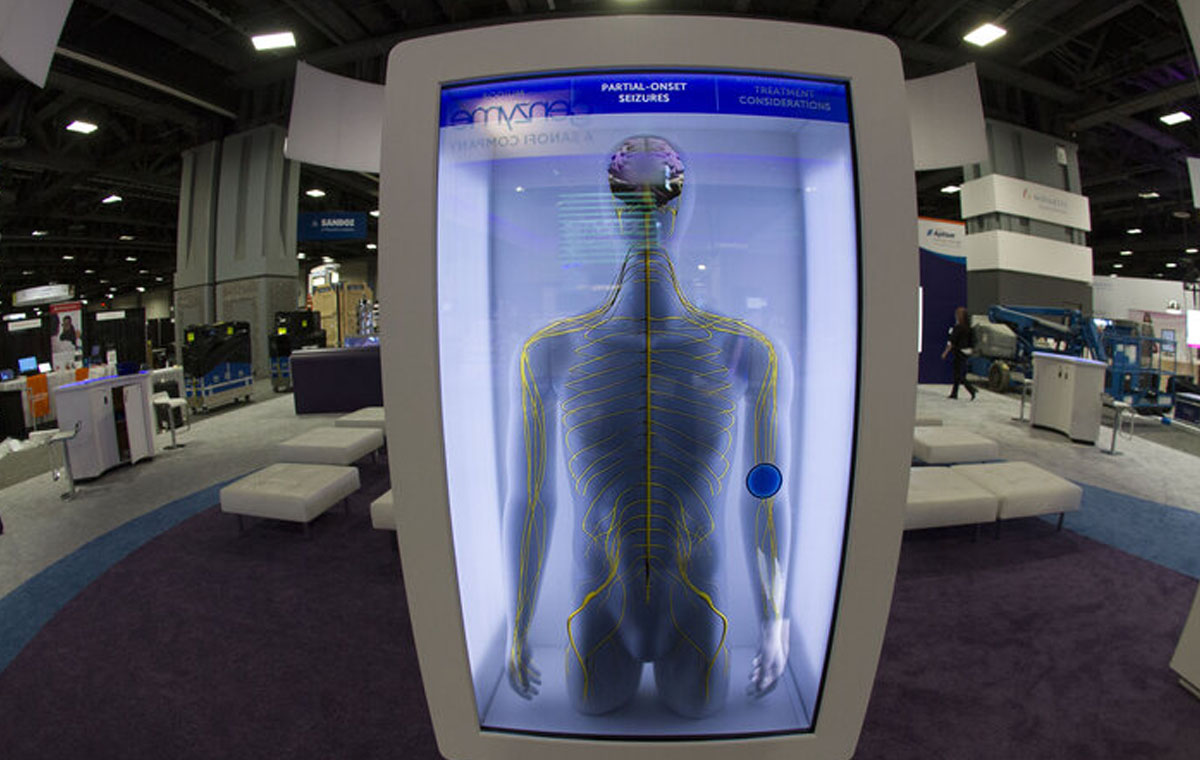Think AR is just for social media filters and video games?
Though it started in the realm of entertainment, augmented reality is quickly making its way from the likes of Pokemon Go and Snapchat into the realm of marketing and advertising for good reason. With 1.7 billion AR device users projected by 2024, the potential of augmented reality for brands is tremendous, and creative companies are coming up with new and innovative ways to leverage the technology to enhance customer experience and elevate their experiential marketing campaigns.
So what are the benefits of augmented reality? And how can brand managers capitalize on this increasingly popular technology?
7 Compelling Benefits of Augmented Reality for Brands
1. Bolsters Customer Confidence
AR allows customers to try before they buy, whether it is checking out how a new sofa will look in their actual living room or getting a preview of where their seat will be at the big game or concert – AR can reduce the friction caused by uncertainty and inspire customers to convert. From retail pop-ups to travel experiences, brands are employing augmented reality to help prospects “see” what they are getting before they get it, from hotel rooms to merchandise -- which increases customer satisfaction and decreases the number of returns.
2. Helps Brands Differentiate
In a sea of increasingly flashy and attention-grabbing experiential marketing strategies, AR can benefit brands by helping them differentiate from competitors. Not only by leveraging the technology itself but by using it in a way that helps illustrate the differences between one brand and another. For example, pharmaceutical companies can use AR to show what a drug is actually doing inside the body, providing doctors and hospitals with a powerful visual that clearly explains how their product works and can benefit patients.
3. Facilitates Customization
Another benefit of augmented reality? It makes product customization achievable. Even better? The process is seamless and efficient for both the customer and the brand, as designs can be created and verified in real-time. From tee shirts to sneakers to cell phone cases – brands can empower audiences to create personalized, one-of-a-kind products and establish new revenue channels.

4. Elevates Sales Tools
If your product or service is high-tech, challenging to explain, or operates in an unseen way, augmented reality can help buyers better understand and visualize what your solution does. This is a tremendous benefit to your sales team, or even to retail or online platforms because it provides a more clear and more direct explanation of what makes your product unique, effective, and superior. For industries like automobiles, medical devices, and even software – augmented reality benefits brands by giving audiences a glimpse inside, which translates into a more comprehensive understanding than would otherwise be possible.
5. Optimizes Service
Outside of sales, augmented reality can benefit brands by elevating the customer service experience. Consider this, you’re a digital camera manufacturer that sells high-end photo and videography products to professionals. Wouldn’t it be nice to have a way for customers to get visually enhanced help with troubleshooting technical issues? Augmented reality makes it possible for brands to engage in more effective ways to better serve their customers, address their challenges, and it contributes to customers’ long-term satisfaction with your product.
6. Is Portable and Accessible
Perhaps one of the best benefits of augmented reality for immersive experiences is that the technology is portable and accessible to just about anyone who owns a smartphone. QR code readers and phone camera scanners act like portable AR devices that most of your target audience keeps on hand, every day of the week.
Brands can incorporate augmented reality into print ads through QR codes, or leverage hidden portals in physical spaces to transport users to exciting virtual locations simply by gazing at their cell phone cameras. Brands have even used outdoor murals as a means to provide a mixed-reality experience for customers – when they view the mural through their smartphone, it morphs into a new experience.
7. Boosts Customer Engagement
AR provides a unique way to engage with customers and expand their experience with your brand, whether they are interacting at an event activation, within a store, or via an app or other online experience. Brands can leverage AR to convey their brand story, explain their value proposition, or educate consumers about the unique characteristics of their products. But they can also use it to reinforce their unique values as a company. Because augmented reality is inherently engaging, it's all the more important to make sure that the technology isn’t being employed as a gimmick, but truly adds value to the overall experience and supports the brand messaging. After all, the goal is for customers to remember not just the experience, but the brand behind it.
3 Ways Brands Can Leverage the Benefits of AR
Augmented reality has revolutionized the way brands offer experiences to their consumers, and by doing so, they have increased their engagement, loyalty, and ultimately sales. Here are three ways brands can leverage the benefits of AR to create memorable brand experiences.
Firstly, brands can use AR to offer an immersive experience to their customers. This can range from allowing customers to virtually try on makeup or jewelry, to visualizing furniture or home decor in their own space. For example, IKEA's AR app allows customers to place virtual furniture in their homes using their smartphones, giving them a unique and convenient way to explore products before they buy. The Whirlpool stovetop AR experience is another great example, as it allows customers to see how the product would look in their kitchen before purchasing, thus enhancing the overall customer experience.
Secondly, brands can use AR to educate their customers about their products and services. This can be used to explain how a product works, how to assemble an item or to troubleshoot an issue with the product. For example, the Volkswagen app uses AR to show customers the interior of their cars and highlight their features. This is not only helpful for customers, but it can also improve sales by educating customers about the brand's products and services.
Lastly, AR can be used to entertain customers by providing them with brand experiences that surprise and delight them. This can range from gamified shopping experiences to interactive events. For example, Coca-Cola's AR experience with Snapchat allows consumers to virtually visit a Coke vending machine and play a game to earn free drinks. Another example is the LEGO Store AR experience, where customers can use an AR screen to see the finished product of a LEGO box before purchasing it. These types of experiences not only generate buzz for the brand but also make shopping more exciting and memorable for customers.
How Will You Leverage the Benefits of AR for Your Brand?
As brands continue to look for new ways to engage their customers, AR offers an unparalleled opportunity to create experiences that are immersive, educational, and entertaining. By leveraging AR, brands can create a more personalized, convenient and memorable brand experience that ultimately drives loyalty and sales.
Given that our online and offline worlds have become increasingly interconnected, brands capitalizing on the benefits of augmented reality today will reap the benefits of being early adopters tomorrow. Since smartphones are the primary vehicle for AR, and the vast majority of consumers already own one, developing the software is all that is left to brands. Understanding how AR can improve customer experience, foster sales, increase engagement, and bolster customer confidence can help marketers determine how to best leverage AR for their specific companies and products.
If you’re ready to explore how augmented reality can benefit your brand, you’ll want a partner who understands not just the technology but also the marketing strategy needed to drive it. At Bridgewater Studio, we help clients bring immersive experiences to life with a foundation in strategy and storytelling. We’ll work with you to understand your goals and objectives and design a project that is tailored to your audience, aligned with your desired outcomes, and customized to your brand. Book a no-pressure introduction to Bridgewater today and find out how we can help you leverage AR for your next brand experience.


.png)
.png)
.png)







